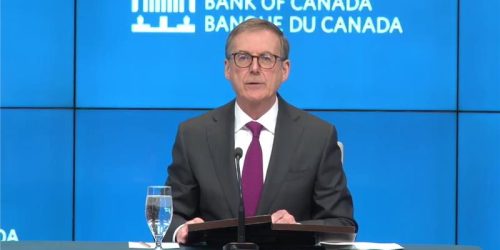Good morning. Senior Deputy Governor Carolyn Rogers and I are pleased to be here to discuss the Bank of Canada’s Financial Stability Report (FSR).
Each year, the Bank assesses the stability of Canada’s financial system and highlights risks that could threaten that stability. While some risks have diminished, the current trade environment has pushed risks higher overall.
But let us look back for a minute before we look ahead.
The country’s financial system has faced unprecedented shocks in recent years, and it has proven resilient. Households, businesses, banks and other financial institutions weathered the upheaval of the pandemic and the sharp rise in inflation and interest rates that followed. It was a difficult period for many Canadians, and pockets of stress remain. But proactive steps taken by households and businesses, together with substantially lower interest rates, put the system on a more resilient footing heading into 2025.
Now, the Canadian economy and financial system face a new threat. US trade policy has taken a dramatic protectionist shift. Tariffs and uncertainty have sharply reduced prospects for global economic growth. And financial markets have been rocked by chaotic policy announcements and reversals.
A long-lasting trade war poses the greatest threat to the Canadian economy. It also increases risks to financial stability.
There are two key concerns.
In the near term, the unpredictability of US trade policy could cause further market volatility and strains on liquidity. In an extreme case, market volatility could turn into market dysfunction.
In the medium term, a prolonged global trade war would have severe economic consequences. It would reduce growth and increase unemployment. This could, in turn, have important ramifications for our financial system. With debt still at high levels, some households and businesses may be unable to keep up with payments. If loan losses occur on a large enough scale, banks could cut back on lending in response. This would exacerbate the economic downturn and put more pressure on businesses and households.
What we are evaluating in this report are the indications of stress in the overall financial system. There are many uncertainties—we still do not know what tariffs will remain, whether they’ll be reduced or escalated, or how long all of this will last. That makes it particularly difficult to anticipate the risks to the financial system.
In our April Monetary Policy Report, we presented two illustrative scenarios to show how a trade war could affect the economy. In the FSR, we’ve focused on the more severe of those scenarios to explore how the trade war could affect different parts of the financial system. To be clear, our analysis is not a projection. It is an assessment of vulnerabilities—pockets of existing or potential stress and how they could spread across the financial system.
Let me turn to the Senior Deputy Governor to outline how these vulnerabilities affect the four key sectors of the financial system: households, businesses, banks and institutions known as non-bank financial intermediaries—a broad category including finance companies, pension funds, insurance companies and fund managers.
I’ll start with households. Total debt relative to disposable income is lower than it was a year ago, but still high by historical standards. Despite lower interest rates, signs of financial stress have risen over the past 12 months, particularly among households without a mortgage. For example, the share of these households that are behind on credit card or auto loan payments has continued to go up.
Among households with a mortgage, 60% are facing renewal this year or in 2026. Most of those renewing will see their payments rise because they took out their mortgage during the pandemic when rates were very low. But the average increase will be smaller than what we expected a year ago.
Still, if a large economic shock causes job losses, it will be harder for some households to keep up with their debt payments.
A prolonged trade war may be that shock. It would cause demand for Canadian exports to fall and disrupt supply chains, threatening jobs and incomes. Workers in trade-dependent industries could find it particularly difficult to continue managing their debt.
A prolonged trade war would matter for businesses too. Most Canadian businesses have managed to adjust to past interest rate increases, and the surge in small business insolvencies last year proved to be temporary. But businesses in trade-related sectors—especially those with high debt, low profitability or low cash reserves—could also fall behind on debt payments.
A strength of our financial system is that Canadian banks are well positioned to absorb higher credit losses. Banks have increased their capital buffers in recent years and, more recently, they’ve increased provisions for credit losses, bolstering their resilience. Liquidity levels remain high, and bank access to funding remains strong. But if credit losses occur on a large enough scale, banks could cut back on lending in response. Struggling households and businesses would have less access to credit to get through tough times. This cycle could exacerbate the economic downturn.
In the non-bank financial sector, the growing presence of hedge funds in the market for Government of Canada bonds raises some concern. Government bond markets are the foundation of the financial system. They need to function smoothly for other markets to work. The increased activity by hedge funds has helped absorb increased issuance of government debt, keeping yields lower and liquidity higher. But hedge funds have also taken on increasingly large amounts of leverage to fund their purchases of government bonds. This makes them more likely to pull back from these crucial markets in periods of stress, introducing added volatility.
The recent gyrations in the US Treasury market clearly illustrated this risk. If the trade war causes a larger spike in volatility than we have seen so far, leveraged hedge funds might rush to sell their holdings. That could strain liquidity across core markets, increasing stress throughout the financial system. Moreover, growing connections between banks and non-bank financial institutions could make it easier for stress to spread. Against a backdrop of increased market volatility, and given their importance in government bond markets, hedge funds need to make sure that they are prepared to respond to sudden liquidity needs without disrupting market functioning.
It’s time to wrap up.
The Canadian financial system is resilient. Despite high indebtedness and the economic turbulence of the pandemic, households, businesses and banks weathered a rapid rise in interest rates. That was a big test, and the financial system proved to be a source of stability.
But we must all remain vigilant. Vulnerabilities remain and there is another test on the horizon.
By identifying vulnerabilities, we can help the financial system prepare for future stress. We are watching developments closely and remain in regular contact with financial system participants and with other authorities in Canada and globally. A stable and resilient financial system absorbs shocks rather than amplifying them, and this benefits every Canadian.
With that, the Governor and I would be pleased to take your questions.

Financial Stability Report—2025
Canada’s financial system is resilient. Overall, households, businesses, banks and non-bank financial intermediaries successfully weathered the pandemic, a period of elevated inflation, and sharp increases in interest rates. But the trade war currently threatens the Canadian economy and poses risks to financial stability.


Press Conference: Financial Stability Report—2025
Release of the Financial Stability Report — Press conference by Governor Tiff Macklem and Carolyn Rogers, Senior Deputy Governor (11:00 (ET) approx.).